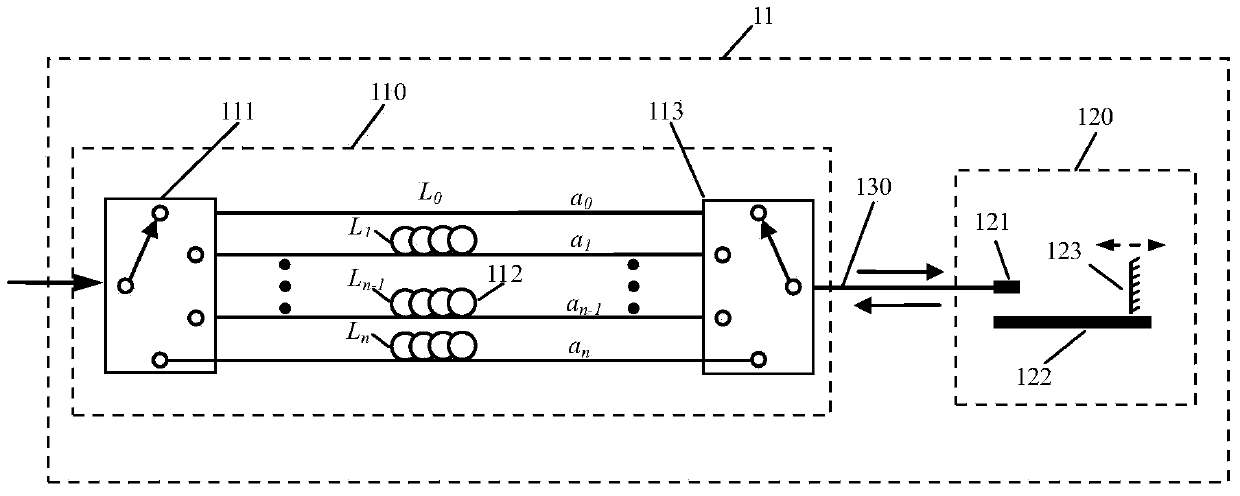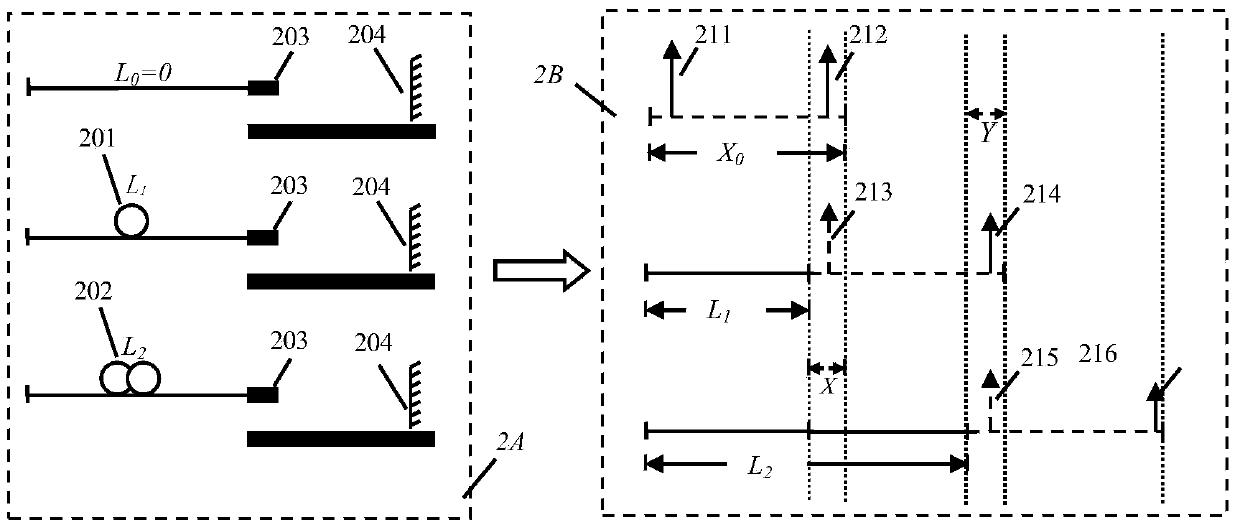Wide-range optical delay device
A technology of optical delay and large range, applied in the direction of optical fiber transmission, etc., can solve the problems of inability to continuously adjust the optical path, complex structure, low precision, etc., to achieve continuous scanning function, flexible and diverse structure, and high scanning accuracy Effect
- Summary
- Abstract
- Description
- Claims
- Application Information
AI Technical Summary
Problems solved by technology
Method used
Image
Examples
Embodiment 1
[0047] Example 1: Reflective large-range optical delay device
[0048] The structure of the delay device is as image 3 As shown, the selection of main optoelectronic devices and their parameters are as follows:
[0049] (1) The extension fiber is G.652 ordinary fiber 312, and the model is SMF28e;
[0050] (2) The working wavelength of the 2×2 optical switch 311 is 1550nm, and the insertion loss is ≤0.8dB;
[0051] (3) The working wavelength of the optical collimator 321 is 1550nm, the optical path scanning distance between it and the movable optical mirror 323 (the reflectivity is above 95%) is changed between 0-200mm, and the average insertion loss is 3.0dB;
[0052] (4) The central wavelength of the optical mirror 323 is 1550nm, the diameter is 20mm, the thickness is 2mm, the average reflectivity is >95%, the parallelism is 90%;
[0053] (5) The program-controlled translation stage 322 uses a 200mm translation platform with a position accuracy of 1 μm.
[0054] in such...
Embodiment 2
[0059] Example 2: Transmission-type large-range optical delay device based on double self-focusing lenses
[0060] Such as Figure 5 As shown, most of the photoelectric device parameters of the transmissive large-range optical delay device based on double self-focusing lenses are exactly the same as those in Example 1. The difference is that in Example 2, the 2×2 optical switch is replaced by 1×8 In the continuous optical path scanning device, a group of optical collimators, a group of optical mirrors and a program-controlled displacement stage are used together. The length of the periodic retarder is no longer multiplied, but two adjacent channels exist. For a fixed optical path difference, the specific device parameters are changed as follows:
[0061] (1) The working wavelength of 1×8 optical switch 511 is 1550nm, and the insertion loss is ≤0.8dB;
[0062] (2) The double optical collimators 521 and 522 and the double optical mirrors 523 and 524 are made of exactly the sam...
Embodiment 3
[0065] Embodiment 3: A transmission-type large-range optical delay device based on a three-port circulator
[0066] Such as Figure 6 As shown, most of the photoelectric device parameters of the transmission-type large-range optical delay device based on the three-port circulator are exactly the same as those in Embodiment 1 and Embodiment 2. The difference is that the device uses a three-port circulator in the continuous optical path In the scanning device, the specific parameters of the circulator are: the working wavelength is 1550nm, the insertion loss is 0.8dB, and the isolation is >50dB.
[0067] in such as Figure 6 In the shown structure, the same as in Embodiment 2, 1×8 optical switches are selected to form an 8-channel optical delay structure, and the optical path differences of the 8 channels are respectively 0cm, 13cm, 26cm, 39cm, 52cm, 65cm, 78cm, and 91cm; scanning The range of the stage is 0-200mm, and the position accuracy is 1 micron. Through calculation, i...
PUM
 Login to View More
Login to View More Abstract
Description
Claims
Application Information
 Login to View More
Login to View More - R&D
- Intellectual Property
- Life Sciences
- Materials
- Tech Scout
- Unparalleled Data Quality
- Higher Quality Content
- 60% Fewer Hallucinations
Browse by: Latest US Patents, China's latest patents, Technical Efficacy Thesaurus, Application Domain, Technology Topic, Popular Technical Reports.
© 2025 PatSnap. All rights reserved.Legal|Privacy policy|Modern Slavery Act Transparency Statement|Sitemap|About US| Contact US: help@patsnap.com



